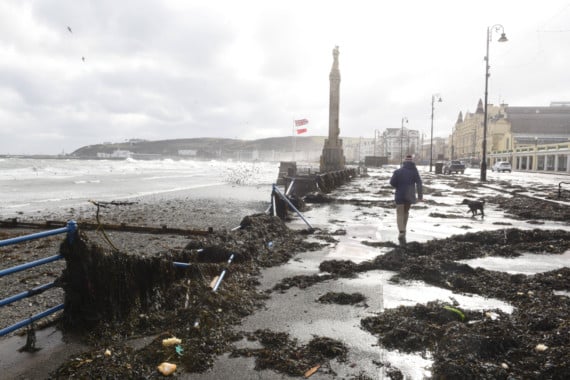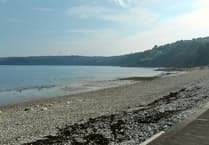The Department of Infrastructure is beginning to count the cost of Storm Emma battering the island’s coastline.
Around 1,500 square metres of the Douglas promenade walkway surface was damaged on Friday.
It is currently being removed ahead of resurfacing, which the DoI hopes to take place later in the week. The cost will be about £30,000.
The Manx Utilities Authority is to replace the sewerage tank covers, which are at the end of their life, before the new surface is laid.
The DoI says the sea wall has been inspected and there is no significant damage. The damaged railings will be replaced at a cost of around £12,000.
In Ramsey, a section of the sea wall will be replaced after the Mooragh Promenade footway collapsed when it was undermined by waves.
The DoI is opting to replace a 90-metre section of sea wall and increase its height to give additional protection against climate change, repeating the process which saw an 85-metre section replaced last year.
The cost of replacing the sea wall and the walkway will be about £180,000.
A DoI spokesman said: ’Overtopping during Friday’s stormy weather caused damage to Douglas promenade walkway, resulting in large sections of the surface being lifted and destroyed. Mooragh Promenade in Ramsey also sustained damage on Friday.’
Minister Ray Harmer MHK added that he hoped the department could begin repair works as soon as possible.
The damage to Douglas’s Loch Promenade and Ramsey’s Queen’s Promenade on Friday caused by high winds and rough seas led to both roads and walkways being closed by police for a period.
In Douglas, the damage stretched along to the prom as the Bottleneck car park and parts of the sunken gardens were left under water for the second time since 2014, while the war memorial was covered in seaweed and a section of railings were destroyed by the waves.
The DoI said: ’Assessments will be made during low tide to check the extent of any damage to the sea wall and railings.
’Department of Infrastructure staff will remove the remainder of the surface early this week to allow the damaged section between Regent Street and the Bottleneck car park to be assessed, and plans can then be made to resurface.
’The area remains closed to pedestrians while the clear up operation takes place.’
The police also captured a sad sight, which was shared on social media - a picture of a cephalopod found on the road on the promenade by the bus stop, on the sea side, opposite The Sefton Hotel on Harris Promenade, Douglas. The police said: ’He was popped back in the sea although pretty sure it was dead. Not much chance it would have survived being thrown by the waves that far onto the prom unfortunately.’
In Ramsey, a section of the Mooragh Promenade walkway collapsed because of undermining caused by the waves.
It is understood the DoI will be examining replacing the section of the sea wall which allowed the sea to penetrate through and under the walkway.
Mr Harmer also told the Examiner the DoI is going to look at the island’s flood defences.
Following improvements to Castletown, Ramsey and Douglas will also be examined and he hopes to be able to see work on Douglas be done during the planned promenade improvements set to begin later in the year.
However, the DoI say this is not due to recent flooding, ’the wall is regularly surveyed and is sound’ the DoI rather see potential work as part of the long term challenges brought on by climate change, challenges that Mr Harmer says the department must meet.
powerful
The Met Office said that while Storm Emma was powerful and caused a lot of damage, it brought little rain, rather what was remarkable were the high tides and gales that raged for nearly two whole days, including a recorded gale force 9, and the temperatures.
February 28 saw a minimum temperature of minus 3C, which is the lowest since 1992, however the March 1 temperature of 1.1C made it the coldest March day on record.
The height of the tide which combined with the wind to cause the damage reached a maximum of 7.1 metres in Douglas.
The Met Office also said temperatures would now return to a ’Manx cold rather than Siberian’, which would feel ’not warm, but certainly less cold’.



.png?width=209&height=140&crop=209:145,smart&quality=75)

Comments
This article has no comments yet. Be the first to leave a comment.